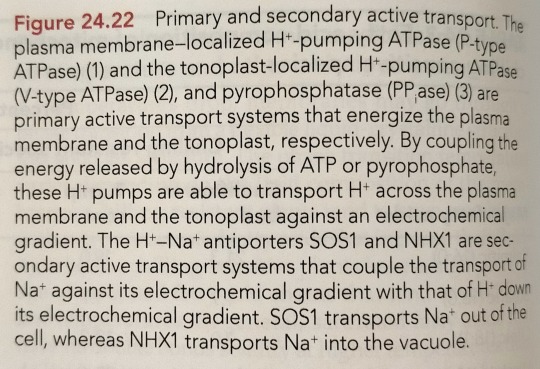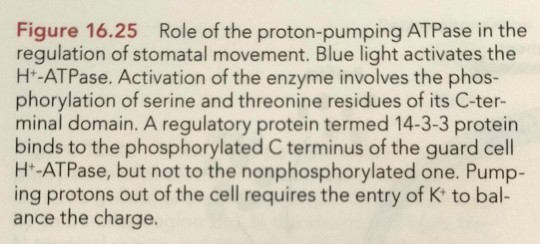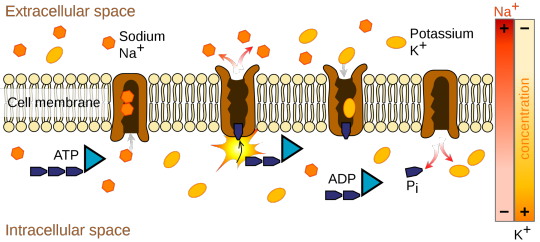#ATPase
Explore tagged Tumblr posts
Text
The energy used to drive these processes is supplied by different H+-pumping ATPases on these membranes (Figure 24.22).


"Plant Physiology and Development" int'l 6e - Taiz, L., Zeiger, E., Møller, I.M., Murphy, A.
#book quotes#plant physiology and development#nonfiction#textbook#energy#proton pump#atpase#plant cells#vacuole#cytosol#apoplast#plasma membrane
0 notes
Text
In particular, the guard cell proton-pumping H+-ATPase plays a central role in the regulation of stomatal movements (Figure 16.25; see also Figures 10.6 and 10.7).





"Plant Physiology and Development" int'l 6e - Taiz, L., Zeiger, E., Møller, I.M., Murphy, A.
#book quote#plant physiology and development#nonfiction#textbook#guard cells#proton pump#atpase#regulation#stomata
0 notes
Text
Creative Potential, Brain Electricity, and Hormonal Influence (PREVIEW)
The brain's steady electric potential, influenced by hormones and the environment, regulates mental function and shapes global consciousness
The following is a preview of a Patreon-exclusive newsletter. Click the icon below to support Become Something New for the cost of just one cup of coffee per month for access to this and upcoming Patreon-only content. ☕📖🧠💪 Patreon […] The physiologist Natalia Bekhtereva pointed out that pathological emotions disrupt the brain’s extremely delicate and complex network of steady electrical…

View On WordPress
#alexander bard#ATPase#biohacking#Childhood#conspiracy#cosmology#creativity#dailyprompt#dailyprompt-1893#developmental psychology#dha#diet#docosahexaenoic acid#empathy#endotoxin#futurism#gaba#gut health#haidut#Health#hippocampus#imagination#katharina dalton#lipopolysaccharide#mental health#mitochondria#neuroscience#Nutrition#omega 3#polyunsaturated fat
1 note
·
View note
Text
that one scene where walt's just verbally tearing down jesse with every awful thing u can imagine is obviously horrific but him saying "and how long before u start using again??" is so especially evil. because he Knows it'll get to jesse and make him feel insecure in his own tenuous sobriety, but worst of all, it'll use their moment of closeness and support in the shooting gallery after jane died against jesse to make him feel bad. walt found him there and took him to rehab in what seemed like an act of grace, of genuine concern, but now he's basically telling jesse that walt never had any faith in jesse's ability to stay sober or better himself. it meant Nothing. this moment where jesse believed he was dragged from the brink of death by someone who actually cared about him, who actually might love him—it was a charade. walt's not just currently withholding affection and approval to hurt jesse and get what he wants, he's poisoning past affection and erasing any hope jesse might have had that somebody believed in him.
#syd squeaks#'how long before u start using again' ill inhibit the na+-ca2+ atpase pump in ur cardiomyocytes and stop ur heart i mean it#breaking bad#walter white#jesse pinkman#walt weaponizing jesse's addiction against him hurts me so so bad. its so fucking evil
34 notes
·
View notes
Text

Canopy Membrane
Tenda membrane atau dengan nama lain, Canopy membran, Awning membrane, Tenda layang, Tenda kelelawar. Tenda dengan kombinasi material membrane yang fleksibel dan kuat dengan struktur rangka yang modern dengan menggunakan sistem tarikan seling, tenda membrane ini mampu menciptakan sebuah bentuk desain yang unik,fleksibel dan nilai artistik yang tinggi.
#konstruksi atap membrane#membran atap bitumen#membran atap bocor#membran untuk atap#membrane atpase#metode pemasangan atap membran#pekerjaan atap membran#rangka atap membran#spesifikasi atap membran#struktur atap membran
0 notes
Text
🧪The sodium-potassium pump🧬
Greetings, Tumblr community! 🧠💡 Let's engage in a comprehensive exploration of the sodium-potassium pump, dissecting its molecular intricacies and elucidating its critical role in cellular homeostasis.
Introduction:
The sodium-potassium pump, residing within the cellular membrane, is an adenosine triphosphate (ATP)-dependent transmembrane protein pivotal for maintaining ionic balance. Its primary function is to actively transport three sodium ions out of the cell while concurrently importing two potassium ions.
Functional Mechanism:
In terms of mechanistic precision, the sodium-potassium pump operates as an ATPase enzyme, utilizing the energy derived from ATP hydrolysis. This primary active transport process involves sequential conformational changes within the pump's structure.
The process commences with the binding of intracellular sodium ions to high-affinity sites on the pump. Subsequent phosphorylation, facilitated by ATP, induces conformational alterations that render the pump receptive to extracellular potassium ions. This triggers dephosphorylation, allowing potassium ions to be released intracellularly.
This orchestrated ion exchange serves to uphold the electrochemical gradient across the cellular membrane, establishing and preserving the resting membrane potential. In essence, the sodium-potassium pump is the architect of the delicate balance between sodium and potassium concentrations.
Physiological Significance:
The physiological ramifications of this meticulous ion transport extend to neuronal excitability and osmoregulation. By contributing to the establishment of the resting membrane potential, the pump plays a pivotal role in regulating action potentials and facilitating the propagation of nerve impulses.
Additionally, the pump actively participates in cellular volume control through osmoregulation. Its influence on water movement prevents cellular swelling or shrinkage, underscoring its significance in maintaining cellular integrity.
For those seeking empirical validation, consider consulting the following authoritative sources:
1. **Alberts B, Johnson A, Lewis J, et al.** Molecular Biology of the Cell. 4th edition. New York: Garland Science; 2002. Section 11.3, The Plasma Membrane.
2. **Nelson DL, Cox MM.** Lehninger Principles of Biochemistry. 7th edition. New York: W.H. Freeman; 2017. Chapter 11, Active Transport and the Cytoskeleton.
3. **Lodish H, Berk A, Zipursky SL, et al.** Molecular Cell Biology. 4th edition. New York: W. H. Freeman; 2000. Section 15.1, The Transport of Small Molecules Across Membranes.

Immerse yourself in the scientific intricacies of cellular dynamics with these foundational resources! 📚✨
#science#biology#college#education#school#student#medicine#doctors#health#healthcare#nursing#nurses#nurselife#human physiology#physiology
148 notes
·
View notes
Text
Propaganda!


Within the cells of some members of basidiomycetes fungi are found microscopic structures called parenthesomes or septal pore caps. They are shaped like parentheses and found on either side of pores in the dolipore septum which separates cells within a hypha. Their function has not been established, and their composition has not been fully elucidated. The variations in their appearance are useful in distinguishing individual species. Generally, they are barrel shaped, with an endoplasmic reticulum covering.
Adenosine diphosphate (ADP), also known as adenosine pyrophosphate (APP), is an important organic compound in metabolism and is essential to the flow of energy in living cells. Energy transfer used by all living things is a result of dephosphorylation of ATP by enzymes known as ATPases. The cleavage of a phosphate group from ATP results in the coupling of energy to metabolic reactions and a by-product of ADP. ATP is continually reformed from lower-energy species ADP and AMP.
#Parenthesome#Adenosine diphosphate#adp#tournament poll#polls#wikipedia#cells of the human body#science tournament#biochemistry#poll#tumblr poll#tumblr polls
7 notes
·
View notes
Text
This week on Teaching Rounds, we're going to talk about proton-pump inhibitors (PPIs). How do they work?
youtube
PPIs block the gastric hydrogen/potassium-ATPase "proton pumps" on the luminal side of parietal cells in the gastric mucosa, thereby preventing the production of hydrochloric acid. They don't stop the reflux of stomach contents into the esophagus, but they do increase the pH and lower the "ouch factor."
7 notes
·
View notes
Note
Thermogenesis in Birds Jose ´ Eduardo P. W. Bicudo, 1,2 Cla ´udia R. Vianna, 1 and Jose ´ Guilherme Chaui-Berlinck 1 Receiûed October 26, 2000 The article discusses the importance of avian skeletal muscle as a source for heat generation by means of both shivering and non-shivering. Non-shivering thermogenesis in birds is still a polemic issue. Recent evidence at the molecularcellular level indicates, however, that this type of heat generation may also exist among birds. The involvement of the sarcoplasmic reticulum calcium ATPase in non-shivering thermogenesis is discussed in-depth. KEY WORDS: Thermogenesis; birds; skeletal muscle; shivering; non-shivering; calcium ATPase. INTRODUCTION The aim of this review is to put together the recent advances in different fields such as molecular and cell biology, and determine how their integration into whole organism biology can provide a better understanding of the mechanisms underlying thermogenesis, particularly in the avian group. Birds and mammals share a lizard- like common ancestry, and the evolution of homeothermy from ectothermic diapsid and synapsid ancestors, respectively, is presumed to have occurred independently, approximately 310 million years ago (Kumar and Hedges, 1998). How organisms respond or adapt to environmental change is one of the central paradigms of com- parative physiology (Schmidt-Nielsen, 1972; Prosser, 1986). Both mammals and birds are found in different environments, from tropical to polar regions and from deep sea (mostly mammals) to high altitudes (mostly birds). Both are able to control body temperature at high constant levels when compared to most other vertebrates. Birds, however, maintain body temperatures of a few degrees Celsius higher than mammals, and small birds may have somewhat higher body temperatures than large birds (McNab, 1966). In mammals, however, there is no clear relationship between body size and body temperature (Morrison and Ryser, 1952). High body temperatures are maintained at the expense of high metabolic rates and indeed birds and mammals have, in general, higher metabolic rates than other 1 Departamento de Fisiologia, The evolution of endothermy in mammals and birds is also related to the evidence that they possess leakier membranes (not seen in ecothermic ver- tebrates) (Else and Hulbert, 1987), which in turn constitute a source of additional heat production. Although this general principle seems to apply to both mammals and birds, they are quite different in many aspects in regards to their thermoregula- tory features. SHIVERING VS. NON-SHIVERING THERMOGENESIS Regulatory thermogenesis in mammals has been the subject of intense investi- gation for many decades, but the physiological responses and adjustments of birds to cold stress has received, in comparison, much less attention; ‘‘this, despite the extraordinary thermoregulatory abilities of small birds and in particular the model system they represent for skeletal muscle-based thermogenesis’’ (Block, 1994). Many small birds winter in high latitudes and face cold temperatures that require elevations in thermographic capacities on seasonal time scales. The thermogenic capabilities of birds of the avian subfamily Cardueline (goldfinches, house finches, redpolls) are impressive and in many cases exceed the abilities of mammals. Goldfinches, for example, can maintain a metabolic rate of five times the standard metabolic rate for 6–8 hr at ambient temperatures of -70°C in winter (Dawson and Carey, 1976). The same birds in the springtime will become hypothermic after only a few minutes of exposure to cold (Dawson and Carey, 1976). This occurs without any change in the aerobic capacity of the skeletal muscles, which are probably the major thermogenic tissues in birds (Carey et al., 1978; Marsh and Dawson, 1982). Flight muscles, particularly the pectoralis and the supracoracoideus, of birds reflect an intense metabolic demand with morphological and functional character- istics that facilitate uptake and utilization of oxygen and energy substrates.

3 notes
·
View notes
Text

#∞: Everyalways
When a Singularitime and an Entrospace learn to work together, they can stand on each other, allowing them to walk anywhere as long as their footsteps are in sync. Turns out neither of them react to the planet's gravity, they are exclusively attracted to the matter of each other. Once a pair figures this out, they make their way out of the planet's atmosphere towards an unknown location in deep space.
Turns out Singularitimes were the fragments of the avatar of Life and Everything That Has Been, while Entrospaces were the fragments of the avatar of Entropy, and The Nothingness That Will Be. Their constant struggle, eternally pushing into each other is what allows the universe to keep existing
Helping every single pair of Singularitimes & Entrospaces get back to space will allow this cosmic being to be whole once more. Everyalways.
Inspiration: Entropy will eventually make all life cease, but without it, Life would be impossible, our cells create order with the sodium-potassium pump, to then open the cell membrane to let entropy do its thing and balance the ions, like a waterfall, this rapid influx powers ATPase like a generator, which creates ATP, Life utilizes Entropy to power itself. In turn, lifeforms increase the heat of any given system, meaning Entropy grows when Life is present. As such, these two forces, Order & Chaos in constant struggle, is what allows our universe to exist as is. So together, they are everything ever.
#creature design#species design#singularity#entropy#cosmos#alien design#aliens#nimalings#Singularitime & Entrospace
18 notes
·
View notes
Text
A regulatory protein termed 14-3-3 protein has been found to bind to the phosphorylated C terminus of the guard cell H+-ATPase, but not to the nonphosphorylated one (see Figure 16.25).


"Plant Physiology and Development" int'l 6e - Taiz, L., Zeiger, E., Møller, I.M., Murphy, A.
#book quotes#plant physiology and development#nonfiction#textbook#regulatory protein#14 3 3 protein#phosphorylation#c terminus#guard cells#atpase#plant cells#plasma membrane#cytoplasm
1 note
·
View note
Text
Target proteins include transcription factors, various protein kinases, Ca²+-ATPases, enzymes producing reactive oxygen species (ROS), and ion channels.
"Plant Physiology and Development" int'l 6e - Taiz, L., Zeiger, E., Møller, I.M., Murphy, A.
#book quote#plant physiology and development#nonfiction#textbook#protein#target protein#transcription factor#kinase#protein kinase#calcium#cation#atpase#enzyme#reactive oxygen species#ros#ion channel
1 note
·
View note
Text
Studying biology gives you access to some very specific and unsettling threats like « I will come to your house this evening and inactivate your Na/K ATPase channels » or « Don’t make me confiscate your dendritic cells »
#confusedfeelsfangirl rambles#biology#I’m studying for an immunology exam rn and I want to cry#why is our immune system so complex
17 notes
·
View notes
Text
"It is poisonous to humans,[5] dogs, cats, and horses.[13] All parts of the plant are toxic, and the plant contains cardiac glycosides.[5] The plant is toxic both green and dried.[14] The stems contain a white sap capable of causing skin blisters.[15]"
Tracking down the sources (5) leads to https://pfaf.org/user/Plant.aspx?LatinName=Apocynum+cannabinum, which in turn cites four sources for its toxicity at https://pfaf.org/user/cmspage.aspx?pageid=174 (1, 4, 19, 62).
Checking out one of those sources (62, from 1982), found it on Anna's archive: https://annas-archive.org/md5/3e8a8a8148cbc2c2afb4b960614a0a87 (also borrowable from IA, though it's timing out for me: https://archive.org/details/fieldguidetonort0000elia/page/282/mode/2up ).

Not exactly super helpful -__- Doing a search on Anna's Archive for just "dogbane" does give this scholarly source though: "Medical Toxicology of Natural Substances || Dogbane Family and Cardenolides" (10.1002/9780470330319.ch147) (https://annas-archive.org/md5/1e3c8186cfe91266972a50468f0fe835).
"The most commonly mentioned folk use was as an abortifacient."
(Well that's a fun side-quest; back to what/how it's poisonous)
"Common oleander contains several cardiac glycosides (oleandrin, digitoxigenin, neriantin, rosagenin) that produce a digitoxin- like effect by inhibiting the sodium - potassium adenosine triphosphatase enzyme system. These cardiac glycosides bind to an extracellular portion of the Na + /K + ATPases and cause increased intracellular calcium concentrations. Minor glycosides in oleander with limited cardiac activity include adynerigenin, adigoside, digitalin, and uzarigenin.11 Because of the lack of toxicokinetics data, the identities of the toxic glycosides or toxic metabolites remain unclear."
"Of over 400 cardiac glycosides isolated from the plant kingdom, most of the cardiac glycosides occur in extracts from the milkweed (Asclepiadaceae), figwort (Scrophulariaceae), lily (Liliaceae), and dogbane (Apocynaceae) families. The highest concentrations of cardiac glycosides are found in seed, stems, and roots, followed by the fruit and leaves. However, the leaves contain the greatest oleandrin concentrations. The concentration of oleandrin varies widely between various strains and species of oleander."
"Oleander poisoning resembles digitoxin poisoning with the predominant symptoms involving the gastrointestinal and cardiac systems. Serious oleander intoxication usually occurs following the ingestion of teas prepared from oleander leaves rather than from the ingestion of plant parts.21 – 23 The bitter taste of the oleander leaves limits the ingestion of oleander leaves in children. Characteristic features of serious oleander poisoning include confusion, marked hyperkalemia, conduction abnormalities, and ventricular arrhythmias. Nausea and vomiting usually occur within several hours, and gastrointestinal symptoms are more prominent following oleander poisoning than following digoxin toxicity. Increased salivation, dry mouth, burning of the mouth, and paraesthesias of the tongue may develop as a result of the local effects of oleander extracts.22 Case reports indicate that the astringent properties of oleander sap produce mucosal irritation.24 The most common serious complication of oleander poisoning is disruption of cardiac conduction.25 Cardiogenic shock, ventricular fibrillation, and cardiovascular collapse may occur following severe oleander toxicity. Conduction delays may persist 3– 6 days, and these cardiac effects resemble classical digitalis toxicity (e.g., conduction abnormalities with ectopy, such as supraventricular tachycardia with atrioventricular block).23,26"
Alright. So... definitely don't eat off of it, and definitely don't make tea with it (the source mentions a case where tea was purposely prepared and ingested, presumably as a suicide attempt). But assuming you aren't trying to ingest it... then sure? It's probably safe as a base for textiles? I suppose the biggest risk would be the textile getting wet and leaching cardiac glycosides, assuming that those glycosides remain in sufficient quantity after processing the stems.
"Although one leaf has been considered potentially lethal, ingestion of larger amounts is probably necessary to produce serious toxicity. Using calculations on the digoxin pharmacokinetic in the antemortem serum from a 96 - year- old woman who died after ingesting oleander tea, Osterloh et al estimated that the apparent digoxin concentration of 5.8 ng/mL was equivalent to the absorption of cardiac glycosides from 5– 15 Nerium leaves.19 The postmortem examination did not demonstrate any evidence of coronary artery disease. Using a crude oleander extract prepared by ethanol extraction, lead acetate purification, and solvent partition, the group estimated that 100 ng/mL of crude extract produced a 1 ng/mL false elevation of the digoxin concentration. Assuming the Vd of digitoxin was 1 L/kg, the estimated absorbed dose of cardiac glycosides was approximately 4 grams, which was equivalent to 5– 15 oleander leaves."
Hmmm. The leaves have greater concentrations than the stems according to the source, so... probably not a huge risk unless you're recycling water without treating it? Or perhaps during the processing of the plant, those that do the processing might consider it an occupational hazard? I mean, if you wanted to have large crops of it, then I'd imagine you'd need certain precautions when processing on an industrial scale.
I mean, at this point, I'm invested and wanna read more. @headspace-hotel, what sources do you have for "In terms of the quality and usefulness of fiber and the amount you get out of it relative to the amount of work it just blows everything else out of the water"? I figure there's a reason that cotton ended up the most used fiber of the textile industry and not any other.
Also @therobotmonster, @teeth-and-spackle, @oldmanyellsatcloud, @cryptidroots, @ilovemosss, probably several other folks that seemed interested in this that I've missed (can't scroll through the reblogs forever).
also I ended up looking at stuff about soviet agricultural experiments and apparently dogbane (Apocyonum cannabinum) was introduced to the USSR as a fiber crop plant? ???
#politics#tech#dogbane#textiles#ussr#apocyonum cannabinum#apocynum cannabinum#abortion#abortifacient#abortifacients#call me mark watney how i be doing botany for fun#botany
6K notes
·
View notes